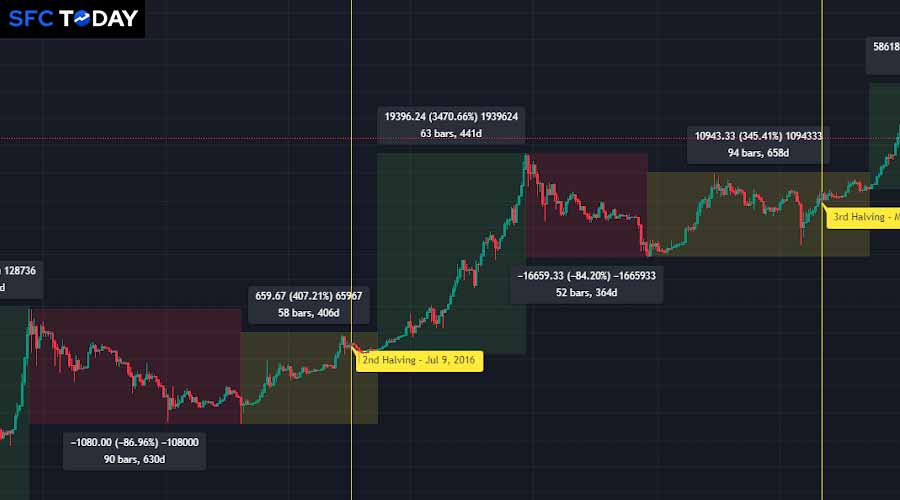This article provides a detailed analysis of Bull and Bear cycles in the Cryptocurrency Market
The cryptocurrency market, like its traditional counterparts, has cycles that can be broadly categorized into two main phases, i.e., bull markets, characterized by rising prices, and bear markets, where prices decline. Complex interplay of factors like investor sentiment, market adoption, technological advancements, and macroeconomic indicators influence these cycles. This article provides a detailed analysis of these cycles, exploring their dynamics, driving forces, and the strategies investors might adopt to navigate through them.
Introduction to Market Cycles
Market cycles are natural economic cycles comprising periods of expansion followed by contractions. In the cryptocurrency context, these are often more volatile than those seen in traditional financial markets. Understanding these cycles is crucial for both seasoned investors and newcomers to make informed decisions.
Characteristics of Bull Markets in Cryptocurrency
- Rising Prices and High Confidence A bull market is typically characterized by a sustained increase in market prices. In cryptocurrencies, this period is marked by strong investor confidence and an optimistic outlook about future prices. This optimism often stems from various catalysts such as increased adoption of cryptocurrencies, favorable regulations, or technological breakthroughs like upgrades to blockchain infrastructure.
- Increased Investment and Participation During bull markets, there’s a notable increase in trading volumes and market participation. New investors are drawn into the market by the allure of rising prices and the fear of missing out (FOMO) on potential gains. Media attention also tends to increase, further fueling the market’s upward trajectory.
- Expansion of the Market Infrastructure Bull markets often spur the development of new platforms, improvements in exchange technology, and the introduction of new financial products such as futures contracts and exchange-traded funds (ETFs). These developments help improve market infrastructure, making it more accessible and robust.
Characteristics of Bear Markets in Cryptocurrency
- Declining Prices and Low Confidence: Bear markets are defined by a prolonged period of falling prices. In cryptocurrencies, these periods may be triggered by various factors such as regulatory crackdowns, technological failures, or macroeconomic downturns. Investor confidence dwindles, and pessimism pervades the market.
- Decreased Liquidity and Market Participation: As prices decline, trading volumes typically shrink, and liquidity dries up. Many investors exit the market to cut their losses, which can lead to a cascading effect of further price declines. The decreased participation can exacerbate the length and depth of the bear market.
- Consolidation and Closures: Bear markets can lead to a consolidation in the cryptocurrency industry. Weaker projects without sufficient backing or real-world utility may fail, and even some established firms may face financial difficulties. This period can be seen as a market correction, purging speculative excesses and strengthening projects with solid fundamentals.
Driving Forces Behind Market Cycles
- Technological Innovations: Innovations such as the development of new blockchain protocols or the introduction of scalability solutions can trigger bull markets. Conversely, technological setbacks or the failure of anticipated projects can lead to bearish trends.
- Regulatory Changes: Regulations play a significant role in shaping market cycles. Clear and favorable regulations can provide legitimacy to cryptocurrencies, attracting institutional investors and sparking bull runs. On the other hand, stringent regulations or outright bans can trigger bear markets.
- Macro-Economic Factors: Global economic conditions also influence crypto market cycles. Economic instability or crises can lead to increased investment in cryptocurrencies as alternative or safe-haven assets, potentially initiating bull markets. Conversely, a robust global economy might see capital flowing back into traditional assets, contributing to a bearish phase in cryptos.
Strategies for Navigating Market Cycles
- Long-Term Holding (HODL): One common strategy is to hold assets for the long term, regardless of volatility. This strategy, known as ‘HODLing’, is based on the belief that despite short-term fluctuations, the long-term trend for cryptocurrencies will be upward.
- Active Trading: More experienced traders might engage in active trading to take advantage of the volatility. This includes strategies like swing trading or day trading, where traders enter and exit positions based on technical analysis and market trends.
- Diversification: Investors can mitigate risks by diversifying their investment portfolios across various assets, including different cryptocurrencies, sectors, and even traditional financial instruments.
- Dollar-Cost Averaging (DCA): Dollar-cost averaging involves investing a fixed amount of money into a particular asset at regular intervals, regardless of the asset’s price. This strategy can help reduce the impact of volatility and lower the average cost per share over time.
Understanding cryptocurrency market cycles is fundamental for navigating the often-turbulent waters of crypto investing. By recognizing the signs of bull and bear markets, investors can better prepare and implement strategies that align with their risk tolerance and investment goals. Whether through long-term investment, active trading, or a diversified portfolio, there are multiple ways to approach these cycles. As the cryptocurrency market continues to mature, it may exhibit patterns similar to traditional markets, but its inherent volatility and innovation-driven nature will likely continue to offer unique challenges and opportunities.







